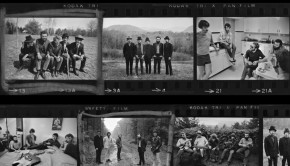Published on May 12th, 2016 | by Mike Ainscoe
0‘BEATLES GEAR’ – All the Fab Four’s instruments from stage to studio
Andy Babiuk
Backbeat Books
Another Beatles tome hitting the Bandwagon bookshelf. And one which to make some impact has to be different. And it hits the mark. Not another biography where you need to search with a fine tooth comb for an interesting fact or snippet which you haven’t read before, or another analysis of the music and the albums with the endless debate of whether ‘Revolver’ or ‘Sgt Pepper’ is the best album (it’s actually ‘Abbey Road’ but keep that quiet).
No, this one is pretty unique amongst Beatles literature. Updated from the 2001 original edition, it’s encyclopaedic and exhaustive in the extreme. The foreword by Mark Lewisohn from the original edition says it all really. As ‘the’ Beatles authority, even he admits that the gap in his knowledge, that of the band’s musical equipment, has now been well and truly plugged. He also points out wisely that “facts, mundanely reported, can become boring very quickly.” To Andy Babiuk’s credit then that this monster volume retains that element of curiosity and appeal. Perhaps it should be subtitled: The Beatles – who played what, when and where. Guitars, acoustic and electric, 6 and 12 string, basses, keyboards, drums, amplifiers – you name it. In expanding 2001’s original version to the ‘Ultimate Edition’ he really does seem to have left nothing uncovered. No doubt nit pickers may find something here or there, but as a Beatles fan as opposed to a Beatles obsessive, the job he’s done is a research project worthy of academic status.
Double the size of the original, 625 new photographs, fresh insights and cataloguing the journey from the early instruments to the new sixties technologies, there’s a familiar yet absorbing commentary which carries the narrative alongside the copious number of illustrations. The appeal for the enthusiast lies in a number of images of original instruments, 43 to be precise, and of course plenty of images captioned “similar to” / “one like this” to get as close as possible to the original instrument.
It’s impossible to pick highlights, yet for how iconic McCartney’s Hofner violin bass has become, there’s a lovely image of his 1964 Rickenbacker 4001S. Originally a red sunburst finish before he painted it in psychedelic decoration (a sign of the times) the image shows the body in its final and current form, sanded down to a gorgeous natural wood. It remains in the owner’s care to this day, but a beautiful looking instrument. Or should it be a historical artefact? The book is packed with moments like that, where readers will make their own choices and the instrument geeks can get excited over machine heads and amplifier buttons. At virtually 500 pages it certainly passes the weight test with quality production values and will sit alongside the Lewisohn books on the packed Beatles bookshelves, as a definitive piece of work.







